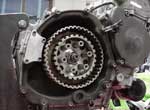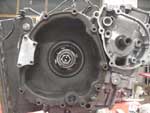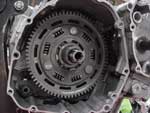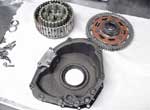|
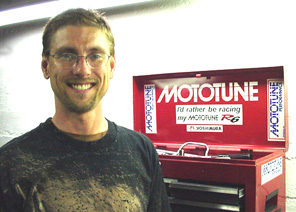

|

Presents:
The
Factory
Superbike
Spy
.
|
MotoMan:
I appreciate the Power News E-mails !! As a matter of fact,
I swear by your website. I'm an instructor at Motorcycle Mechanic's Institute in Phoenix, Arizona where I teach 4-stroke performance. Part of our curriculum covers head flow, flow benches and porting.
Needless to say, I've incorporated much of the info from Power News into my presentation (with the proper credit) and encourage my students to visit the site for additional information.
Again, many thanks for providing this information that some refuse to
divulge or have a need to charge for.
Regards,
~Mr. Kohlbrecher
. |
Hi Mr. Kohlbrecher !!
Thanks for giving Power News the
"thumbs up" ... it's truly a great honor to be
recognized by the MMI !!!!
   
Sincerely,
~MotoMan |
MotoMan:
Your website is a total JOKE. It's unscientific, and unprofessional.
This so-called "secret info" goes against all accepted theory about engines.
You need to get educated before you write this garbage.
~Kent
Hi Kent !
Thanks for your feedback !!
Lots of people are skeptical of this information, because it directly
opposes
so many accepted theories. Don't worry, this is the normal process of science.
As always, I work extra hard to make each  issue better than the last.
issue better than the last.
Hold on to your hat ... This Is The All New Power News Magazine !!
Sincerely,
~MotoMan
Breaking News:
|
Power News Reader Has
Never Ported
A Cylinder Head Before;
Beats Famous Professional Tuner By
6.6
HP !
|
|
Hey MotoMan:
OK, I race a 2001 Yamaha R6. Well, I just got my engine together and
running when I found your web site. I read every page on the damn
thing, ok .... I read it more than once a day for the past week.
So I called up my friend who has a portable dyno and ran the bike to
him and ran it. The head was ported and polished by { Famous Race
Tuner -- Name Withheld } Key word was ported and polished !!!!!!
I've never ported a cylinder head before, but as I read Power News, it made total sense, so I ran into my bike
room and yanked it back apart ... this was last Tuesday.
Well luckily I have friends at the local Yamaha shop... I used to be
service manager there. So I got all the tools I didn't have. I
got engine back together around 9 a.m. Sunday...
I just got home from the dyno and it gained 6.6 hp !!! ... all
of my friends including many mechanics from my local area told me
"sounds like it may work" but were still skeptical.
I had 101.3 before and I got 107.9 and the damn bike pulled till redline, I mean off the
charts. Air temp was only 3 degrees colder today then last Tuesday when
I dynoed it the first time and I ran the same gas that was in the tank from
then also. The tech who dynoed it was like "what do I got to rip apart
to do this !!!!" HAHAHAHAHAHAHAHA
Well thanx for all the help soon as you gimme great ideas for my exhaust,
I'll be pulling it apart also keep up the great work !! Thanx for having faith in all of us to do this ourselves ...
I
can't believe I gained 6.6 hp !!!
~Anonymous Racer
(If you want to publish this letter, please keep my name anonymous, I
don't want my competition to
know about this.)
|
|
Hi Anonymous Racer,
Right On !!
It's great to see that people are benefiting from Power News !!
Now that you've beaten { Famous Race
Tuner -- Name Withheld } by such a massive amount of horsepower, you're actually one of the best
now ...
   
Sincerely,
~MotoMan
|
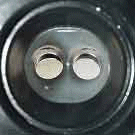
.
It's true, you could spend $50,000
dollars
on
one of these engines, and not one modification will
gain as much power at all RPMs as
high
velocity porting does !!
|
Where
else can you learn how to
mercilessly beat famous professional race engine tuners
all for the incredibly low cost of ... (free) ???

" It's 'unscientific'
.... it's 'unprofessional' .... and perhaps worst
of all:
" it goes against all accepted theory about
engines..."
But, when real people go
against the accepted theories and scientifically
test this info,
they soon find out that they're beating the professionals
!!
|
|
Welcome Engineers !
.
Since Power News began, I'm happy to say that engineers from 3 of the world's major automakers,
2 construction equipment manufacturers, 1 world renowned audio company, and even 1 motorcycle manufacturer (hint: orange & black )
have subscribed. )
have subscribed.
In this issue, we'll take an inside look at some advanced engine
technology from Suzuki, and I'm also going to introduce a concept which I
call "Championship Horsepower".
At the same time, we'll consider ways in which engineers can increase
their ability to
come up with creative new innovations.
.
What if, like the Anonymous Racer above who gained 6.6 horsepower ...
you're not an engineer ???
Consider this:
.
the moment we even think about modifying a motorcycle or car or snowmobile
(or just about anything) from it's stock condition to increase performance ...
We
All
Become
Engineers ... Yes, Even You !!
.
(Welcome Everybody !!!)
. |
|
|

.
|
The $ 50,000 Factory Superbike Engine !! |
Inventions
When Thomas Edison announced his first successful light bulb,
another top inventor from the same era said:
"Such startling announcements as these should be
deprecated as being
unworthy of science and mischievous to its true
progress."
~ Sir William Siemens, 1880
.............................................................................................
... Then 15 years later, Thomas Edison had this to say about the possibility of
airplane flight:
"It is apparent to me that the
possibilities of the airplane, which two or
three years ago were thought to
hold the solution to the flying machine problem,
have been exhausted, and that
we must turn elsewhere."
~ Thomas Edison, 1895
..............................................................................................
.
Oooops !!
..
if it had only
been up to Sir William Siemens, we'd still be reading by candlelight,
.
and if it had only been
up to Thomas Edison, we couldn't fly in airplanes.
..............................................................................................
There's something peculiar about the way that all
people think, when even these
2 creative geniuses and (mostly) open minded thinkers could make this same
mistake ...
A "99.999 % open mind"
is still 100% closed to
all of the possibilities !!
It's true !!
How can all
of the possibilities be considered if one's mind is
closed off to even .001% of the possibilities ???
That seemingly teeny-tiny little .001% is actually
a huge barrier
to the inventive process and
slows it waaaaaay down.
Since most great innovations are found where people least expect to find
them,
this area is in what I think of as "the .001% zone" !!
( The .001% Zone = Electric Light Bulbs &
Airplanes, Smaller Ports, Turned In Exhaust Pipes & Hard Break-In !)
... so how can we speed up our inventiveness ???
What is it that makes creative inventiveness ??
.
It's a
combination of 2 seemingly opposite qualities...
Artistic - Creative and Scientific
- Logic.
 |
.
First, the right side of the brain
generates a creative thought ...
... then the left
side of the brain uses logic to test it's validity.
. |
|
Aha !!!
When it's put this way, these "opposite qualities" suddenly
aren't so opposite !!
There's something about this statement which hints at the secret to how
you can:
"Think Outside Of The Box"...
Can you see it ??? |
Consider the qualities that make up "Invention Intelligence":
Scientific - Logic Intelligence
As we learned in the last issue of Power News, cognitive dissonance
can often subvert even the most highly intelligent people's ability to think logically.
Another way of saying this is:
Whenever new information pits the emotional mind against the rational mind....
emotion usually wins.
Not so with Mr. Spock !!!
|

Mr.
Spock
( Scientific - Logic)
|
In the '60's TV show Star Trek ... the
adventures were different each time, but did you notice the one theme that
remained constant ??
If you boil down the Star Trek " formula " it was this:
Mr. Spock didn't require the whole episode for the truth to gradually "soak
in", the way his human counterparts Captain Kirk and Dr. McCoy
did.
In fact Spock instantly understood what was going on in a
given situation !! The humans couldn't "see" it, despite their
high levels of training and intelligence.
Why ?? Mr. Spock's advantage was that whenever he faced a tough
challenge, he didn't go through the usual ego / fear battle, and so his
mind was never distorted or frightened away from immediately seeing the exact truth.
My point is:
Spock wasn't
any more intelligent than Kirk or McCoy !!
The only difference was that it was impossible
to fool his rational mind !!
This seemingly small difference made Spock immensely more
intelligent in the "real world" application of intelligence.
(which is all that really matters when you think about it ...) |
( Of course "Spock" is
a fictitious TV character. The lesson in this TV show is that even the smartest humans
can have a huge "IQ" increase, just by practicing pure emotionless logical thinking the
way Spock did. )
What was Mr. Spock's weakness
???
Far from being the "ultimate creative inventor", Spock's strength
as a purely un-emotional logical thinker was his weakness as a
creative
thinker !! Whereas logical skills come from the left side of our brain ...
Artistic skills come from the "emotional" right side of our
brain,
and are critical to creating new ideas ...
Artistic - Creative Intelligence
He had the absolute cooooooooolest
mustache
the world has ever seen !!!
.




|
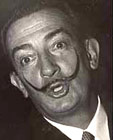
Salvador Dali
( Artistic - Creative)
|
Spain's Salvador Dali "invented" surrealism, which is the really
the juxtaposition of common, ordinary things in a new way that made the
result quite uncommon and very extraordinary.
Dali's genius was an amazing ability to put familiar things together
in a
whole new way ....
(This is the essence of invention)
|
|
Take a moment to unlock the creative (inventive)
right side of your brain:
Although there are more famous examples of Salvador Dali's surrealism, I
chose this painting because it also illustrates another, more subtle kind
of intelligence.
As you look at the full sized version of this picture, you'll
quickly notice that if you only look at the spheres
in this painting, you can't actually see the "big picture" Dali has
painted. Once you take the focus off the details, your brain easily fills
in the blanks.
Think about the message here:
Like most things in life,
the harder you focus on all the little details,
the less you can actually see.
(It's impossible to see the forest, if you only look at one tree at a time
!!)
|
Click Here :
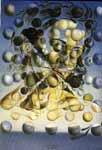
Galatea of the Spheres
~ Salvador Dali |
When both
sides of our brain work towards a 50-50 balance, we get super intelligence.
but ....
When one side tries to dominate or fight the other side, we never see the "big pictures".
.
Here's a big picture:
|
"Wouldn't it be great to see Harley-Davidson get
back
into roadracing ???
.

I'm 100% sure that with a little help,
Harley
can WIN !!! "
(so, let's take a little peak at
what Suzuki's doing ...)
|
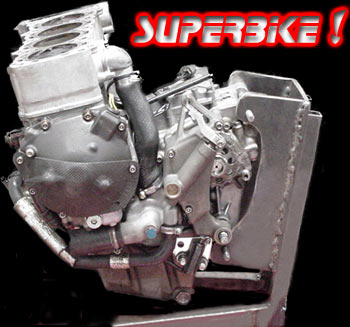
|
Wow ... O.K. let's go totally
berserk and start ripping
this
motor apart to see
all the cool trick parts !!!
|
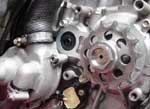
That water pump is all magnesium !! Not exactly a mass-produced part...
The countershaft sprocket has been drilled to the max...
|
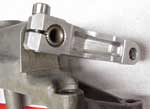
Super light clutch actuator and
magnesium cover !
Even the small bolt is aluminum...
.
|
Whoa, whoa, whoa ...not so fast !!!
It's easy to get excited and let our emotions
take over.... we may be tempted to just rip into this motor to see what's
inside.
What's the first logical thing we should always do before taking apart an engine
???
Hint: this was the subject of the most important, yet least
"glamorous" Power News article.
(*Clean it 'til you can eat off of the parts*) !!
.

MotoMan eats his Cheerios out of a
really clean engine oil pan !!
|
|
O.K... this is a $50,000
engine, but even 1 speck of
dirt in the internal parts of any engine is too way much
dirt.
Practice this concept on the $1000 engines, and someday
you
will be working on the $50,000 engines !!!
.
|
|
.
Even Professional Race Mechanics Make This Mistake !!
.
Watch carefully at the next time you're at a superbike race, and you'll see that "clean"
isn't usually a priority. You'll see it all ...dirty tools ....
panicky mechanics setting
oily clutch
parts on the pavement, then putting them back into the engine ....setting a greasy axle down
and
then running after it as it rolls away, only to re-install it with a fresh layer of
grit ...
.
... and who can forget that famous
line heard at racetracks all over the world:
" Oooops, I think a little dirt just fell down into the ports
while I was tuning in the jetting ".
Ironically, there's often more power
lost to dirt ruining the valve seal, than gained from re-jetting.
In addition to the massive power loss from
friction and
valve leakage that dirt particles
cause, many preventable engine blow-ups and
wheel
bearing failures "happen" from
not heeding this rule 100%.
I
can't emphasize this enough:
Don't even disassemble or work on engines outdoors or in any dusty
environment !!
.
Think surgery, no, think even cleaner than
surgery. :)
Now we're ready to get out the wrenches ...
... wait a second, are they clean too ???
. |
Pistons & Combustion Chamber Design
.
By making just one change in the design philosophy of the piston and
combustion chamber,
Suzuki engineers have reaped many benefits. In this case, it's not just one
change that
makes more power, but rather that one change then allows for the
added synergy of many advantages.
This is the quality that distinguishes "genius" level design from
"really good" design !
It's the ability to see the big picture...
A Quick Review of
"Squish" Area
The purpose of the squish area in an engine is to force the fuel and
air mixture into
the center of the combustion chamber as the piston approaches
the top of the compression stroke.
This motion keeps the fuel and air moving (and mixing) as the flame spreads
through the
fuel/air charge,
and it also minimizes charge heat loss from
the outer edge of the combustion
chamber.
To maximize these effects, the squish area must match the cylinder head
perfectly. The easiest
way to do this is with flat squish area on the piston which easily matches the
perfectly flat surface
of the cylinder head, and this is how most production squish designs work.
|
The "Curved Squish" Design
These Cosworth pistons have a curved squish area on the sides of the pistons. The front and back use the traditional flat type
squish areas.
It's much easier to match 2 flat surfaces, than it is to match 2
curved surfaces. Especially since 2 different companies (Cosworth &
Suzuki) are making the components !!!
..
The curved shape of the piston matches the cylinder head angle very well.
This is hard to do in a production engine, so that's one reason this
engine is so expensive. The fact that these parts match as well as
they do indicates a high level of
quality control at both
companies.
.
|
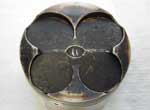
.
The curved squish areas are on the left and right raised sides of this
piston. The flat squish areas are on the top and bottom in this picture.
I recommend numbering the pistons before they're removed from the rods, so
they can't get mixed up.
.
(No, it's not an 11 cylinder,
I just used roman numerals)
 . . |
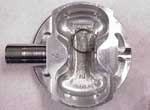
The bottom of the piston.
Although these are very light
pistons, they're not as light as some newer designs.
Notice the machined out area above the wrist pin boss ...
Cosworth really
" Goes For It "
.
.
. |
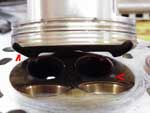
Here you can see how the
fuel/air mixture is forced to the center of the chamber.
The red arrow on the left indicates the curve of the piston, the arrow on
the right indicates one of the white spots where the piston is getting
closer to the head than the rest of the curved squish area.
.
.
.
.. |
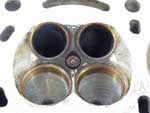
Here's the evidence that it worked ...
The darker center of the combustion chamber is where the burn is initiated. The 2 white spots are
where the piston lightly touches the head at
max RPM. The light brown outside areas are where the rest of the piston almost
touches the head at max RPM's...
Here's an opportunity
for more power !!
|
..
To Improve This Engine
The ideal situation is for the "white spot" to be in the entire squish
area. That way 100% of the fuel/
air charge is forced out of the squish areas and
into the center of the combustion chamber.
I'd start by sanding down the 2 areas of the piston that are
creating the "white spots" by .001", and then tighten up the
overall piston to head
clearance by .001" (.025mm)
This kind of work is "blueprinting" each
individual piston to
cylinder head fit; beyond what's possible with even the most precise production
standards.
Needless to say, it would be very "trial and error" to get an
engine 100% right. The engine would have to come apart after it
was run awhile, to see if the contact is correct, and then maybe a second
clearance adjustment would have
to be done
to get it perfect.
.
|
Go
For It !!

.
.001" is very small, just like the .001 percent
zone.
.
99.999 % would say:
"That's way too much work, besides it's already close enough".
If you want to beat the factory teams, you can't afford to think
this way !!
. |
Hey ... wait a minute
Older "high dome" style piston designs increase the compression
while
incorporating the squish effect also ...
.
So, you may be wondering ...why go through all this effort to
accomplish the same thing ??
.
(That's a good question ..... the answers reveal the genius of this
design !!!)
The "Hidden" Benefits:
.
|
1) Un-Shrouded
Valve
The
valve flow is more open near the (side) edges of the combustion chamber, so the
incoming fuel and air charge flows around a greater percentage of it's
circumference !!
2) Less
Surface Area
The combustion chamber and the piston are less convoluted. This is
especially true of the piston, where a traditional "high domed"
high compression piston adds a lot of extra surface area to the combustion
chamber.
3) One Combustion Chamber
That's right ...with very high
compression ratios, a "high dome" style piston effectively splits
the combustion chamber into 2 halves as the flame is beginning to spread.
This inhibits the
flame travel and lowers combustion efficiency.
This design eliminates this problem by concentrating all of the mixture
into one small uninterrupted area right around
the spark plug !!
. |
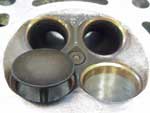
Less surface area =
Less heat loss =
More power !!
In keeping with this philosophy, you can see that the factory titanium
valve is a flat-face type, not seen on most production engines. Again,
this allows for a combustion chamber with
less surface area.
The only production motorcycle engine that
I know of that used perfect dimple-less flat faced valves was the '94
Kawasaki ZX6. The newer ZX6Rs use flat faced valves with a small dimple...
|
Money Doesn't Automatically Buy More Horsepower
!!
Notice that this engine uses surface gap (non-electrode) racing spark
plugs.
These are brutally expensive ... they're around $60-$80 each !!
I once tested the NGK CR9EK spark plugs featured in the 2 Free
Horsepower article against
these racing plugs in a '98 supersport GSXR 750, and we found that the off
the shelf
$8 CR9EK's were actually better !!
It's possible that this engine requires this type of plug for piston
clearance or other reasons,
but it goes to show that just because it says "RACING" on the
package, doesn't
automatically mean it will make every engine faster.
.
Accurate Scientific Testing = the best
way to find out the truth.
Reading The Package = the worst
way to find out the truth. |
"Break In Secrets Part 3" ...
In the Future Horsepower
article, we found out some
startling news ....
... in Japan, the manufacturers warm the brand new engines up and then blast them right up
to redline at the end of the assembly line !!
Of course, this breaks all the "rules"
they set in the owner's manuals !!
(I wouldn't be surprised if some non -
Japanese motorcycle manufacturers run their new engines hard too ...)
A Little
Knowledge Changes Everything
.
Fear of "severe engine damage"
has long kept people from thinking about what actually happens
inside of a new engine during it's first few hours of operation.
Suddenly, the premise of taking it easy on a new engine has a
whole new perspective
for Power News readers who are in the know about this situation.
Hey MotoMan:
At the Harley factory in York, PA. they put the new bike on a dyno
and run it for about 5 minutes at 75 mph.
~ B 68
Thanks B 68 !!




Sincerely,
~MotoMan
More Evidence:
This Factory Suzuki Superbike engine costs as much as 5
complete
brand new bikes,
and the entire bike costs as much as a nice sized house for a family of 4 ...
Yet the owner warmed it up and broke it in with hard acceleration and
deceleration
according to the Power News Break-In Secrets article !!
.
Was he "Totally Crazy" or just "In
The Know" ??
|
Dude, who stole the
2nd piston ring ????
No one did ...
To minimize friction, these pistons use only 1
compression ring instead
of the usual 2 !!
This engine seals it's super high compression ratio perfectly well with 1
ring !!
Yet, without
the "backup" 2nd compression/oil scraper ring, it would be an oil burner if it had been broken in "easy".
Plus, it would be a very slow bike ...
.
|
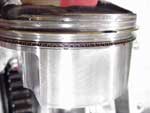
Only 1 Compression Ring !!
Like "magic" there is
absolutely no scuffing or distortion on the piston...it looks almost
brand new !!
|
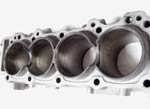
.The cylinders are in
perfect condition !!
Like "magic" there's no scuffing in the cylinders
either !!
.
|
|
.
" Yeah, but .... it's a
racebike and they don't
go as many miles between rebuilds "
That's true, but consider this:
.
Anyone who's taken a lot of engines apart will agree that most street bike
pistons &
cylinders don't look this good, yet the average RPM most street
bikes
are run at is about 1/3 of the average
RPM of this bike !!
After 2 seasons of ultra high RPM roadracing use ...
There's really no wear at all !!
*The key to exceptional engine
reliability is to first achieve an exceptional ring seal*
.
Power & Reliability Are 100% Connected !!
|
|
Hi MotoMan,
Thank you for the "damn the torpedoes, tell the truth till it
hurts" approach on your site.
I wish the rest of the world would behave this way.
I have a question about the pictures you have
of the two pistons in engines broken-in differently. [Note: these photos
were featured in the Break-In Secrets &
Future Horsepower articles]
The one piston with obvious signs of blow-by explains your point very
well. The other piston shows no blow-by and that's OK, but I am mystified
by the total lack of combustion by-product discoloration on the top of the
piston. That piston looks like it was cleaned whereas the other piston was
not.
How do you explain this?
Thanks for the great site !
~Alan |
Hi Alan !!
Thanks for writing , you've brought up a great point !
The pictures of the pistons are un-retouched & the pistons themselves
are un-cleaned or otherwise modified to make my points. It wasn't a freak occurrence
either ... there are lots of pistons like this in my
"collection".
I realize that these clean pistons seem almost magical ... kinda like
"pulling a rabbit out of a hat", but I assure you that there's a
rational explanation for it:
The rings seal so well that no significant oil ever reaches
up past the top ring land, and it never even gets near the combustion chamber.
Since the top ring doesn't allow combustion leakage below it, the heat and
oil never meet ... there's no burnt oil !!!
There
is carbon on the very top surface of the "clean" piston in the
other articles, but it's only
fuel carbon. You can't see it in the photos, because the piston is tipped
to highlight the ring area, not the top (combustion chamber) surface of
the piston.
There's also a very simple explanation as to why most people have never seen such clean
pistons:
most haven't broken in their engine this
way !
They say a good magician never reveals his tricks ... ( Oooops. )
   
Sincerely,
~MotoMan
.
|
Like Magic
!!
The second
compression ring on a piston also acts as an oil scraper, so this
single ring superbike piston is seriously "handicapped"
when it comes to oil control...
That's what makes it an even more impressive example of this phenomenon
than the pistons in the original
Break In Secrets article. |
ABRA-CADABRA !!!
.

No burnt oil in the ring lands !!
.
After 2 seasons of
racing,
there is a slight brown residue developing
by the valve reliefs ...
. |
|
Titanium Connecting Rods
Allow for increased high & low rpm power
potential !!
The High Rpm Advantage
Super light titanium connecting rods allow a higher RPM
limit, because the crankshaft isn't stressed as much. This might seem like
a really big deal, until you consider that the engine is only at the maximum
RPMs where Ti rods are required for a relatively short period of time during a
lap of the racetrack.
Of course, the very lightness of these rods is an acceleration advantage. When
you think about how fast these parts have to accelerate, stop and accelerate ...
lighter reciprocating parts always do this easier and with less power loss. This
could be called "The Obvious Low RPM Advantage
..."
|
.
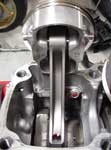
Titanium Rod
is a
Work of Art !!
.
.
.
.
.
.
. |
The Secret Low Rpm Advantage
Since steel rods stretch more than Ti rods do at high rpm, an engine using
steel rods needs more initial piston to head clearance to keep the piston from
hitting the head at redline. As a steel rod stretches, it's like the head
is being "milled" .024" (.6mm) !!! That's right, the
compression ratio increases considerably as the engine revs up ... because
of rod stretch !!
But, since Ti rods don't stretch as much, they allow for tighter initial piston to
head (squish) clearance. This means that with Ti rods, the actual compression ratio
will be higher at low RPMs than it is in a steel rod engine !!!
This means that anytime the bike is accelerating it has this
advantage. Note that during a race, this condition exists for a lot more time
than max RPM does !!
Here's the catch ... most tuners don't know about this !! Most set the
piston to head clearance to the same spec that steel rods require. Since the Ti
rods don't stretch as much, an engine set-up this way will lose it's
potential low RPM advantage. Worse yet, it will actually have lower
compression
at high RPMs than a steel rod engine does !!
That's a lot of money to spend to
make less power ...
.
Oooops !!
Many people spend around $1,600 - $2,000 for a set of 4 Ti rods,
completely unaware that the biggest potential power increases from
these
expensive parts isn't even being exploited !!!
...
|
How racing helps to develop a better product for street use
...
|
Rod failure
plagued the '96 - '98 Suzuki 750's; the problem was that the small ends
were too thin. Most racers found this out the hard way after 4 or 5 weekends of
racing, and occasionally some street riders' engines failed because of this
same problem.
Suzuki has since turned this situation around, and
today their stock
rods are some of the best in the business !!
Right on Suzuki !!
,
|
|
|
Here's where some of that knowledge came from !!
These racing rods are reinforced in the areas that the stock '97
rods weren't ...
.
.
.
.
.
.
.
.
.
. |
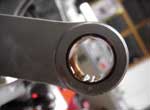
The small end is very well reinforced and the top is much thicker than
stock !!
Oil reliefs in bronze inserts allow for small end lubrication.
(I should have cleaned the oil off before I took this
photo, but if you look close, you'll see the 2 relief areas, especially
the highest one in this photo)
.
|
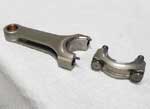
.
2 piece Ti rods are so light, they feel like they're made out of
plastic
!!
Look at the upper part. The extreme " H " beam shape maximizes
strength while using the least amount of material possible.
.
.
.
|
... we interrupt our regularly scheduled program to bring you this
important
Late Breaking News:
|

|
Venezuela's First Power News Subscriber
is Absolutely Flyin' !!
.
|
|
.
I met Antonio Piccioni at the Latin American Superbike Championship
in Dominican Republic,
at the start of his racing career. At first, we had a language barrier...
but, my friend (& official Spanish translator of Power News)
Marcos Peguero was there to help !!
As I explained my 8 Phase Engine concept, Marcos translated it back to
Antonio in Spanish.
I handed him a Mototune USA.com card, and said "sign up for the
Spanish Power
News,
read the next few issues, and if it makes sense, maybe we can work
together someday."
Would the Power News engine concepts be tested in South America ???
Sure enough, last
summer the MotoMan "un-retired" from engine work to help out
this
up-and-coming new race team !! The first race with the new motor resulted
in an
impressive 2nd place in Venezuela's National Championship race in August
!!
Incredibly, Antonio took his 2nd place ...
in the blazing heat of 107 degrees Fahrenheit
(42 Celsius)
(ooooooo ... that's hot !!)
Then suddenly ...
Antonio Piccioni & Team
Motore
headed north to race in the USA.
So ... how did it go ???
. |
|
" Go Picci "
.
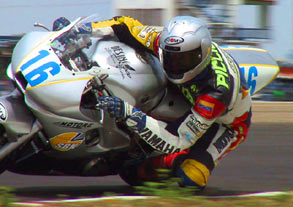
Photo by
Octavio
Estrada
.
Antonio "Picci" Piccioni
.

The Pride Of Venezuela !!

Sponsored By:
Motore SBK
Venemotos-Yamaha
Suomy Helmets
Repamoto
World Wide 750 INC
Leo Vinci Exhaust Systems
Superbike Moto Rentals
Mototune USA |
Moroso
In his first ever roadracing trip to the USA, Venezuela's
Antonio "Picci" Piccioni won 2 races
and took a second place at Moroso Motorsports Park
in
West Palm Beach Florida !
Never seen the track, two wins & one 2nd place.
.Unreal.
Daytona
With only the Moroso event to qualify for the Daytona Race of Champions, Picci
had to start from the
back of the grid.
Things looked hopeless, but Picci
simply ripped through the huge pack of adrenaline crazed 600 riders, and
finished 4th place in his first trip to the
ultra high speed track !!
Outrageous.
Homestead
Another new track to learn ...
Results:
Two 2nd place finishes, a 3rd
place and
one very hard crash.
(Picci
was not injured in the crash !! )
Sensational.
Picci's stunning speed was noticed by everyone at the race events,
and is another example of the amazing power increases that can only
come from
thinking outside of the box
!!
Congratulations from Mototune USA and...
... the rapidly growing number of worldwide readers
of Power News who are all cheering
" Go Picci "
right now !!!
|
Hey Pat !!!!!
Here in Florida my bike is the fastest R6. Some guys ask me, if I have an R1
motor... :)
When I took my bike to the Dyno, one guy ask me, if I prepare the
motor. When I said
MOTOTUNE USA, the
guy is going crazy !!!
For the next year, I'm looking for some sponsors to race the FORMULA USA !!
Thank you for your support.
~ Antonio Piccioni
Picci's
Team Motore Venezuela Yamaha R6 contains many more
never before seen Mototune
USA tuning secrets
!
{  Stay tuned to Power News to learn all
the tricks
Stay tuned to Power News to learn all
the tricks  }
}
Plus:
2003
Yamaha R6 Tuning & Set Up Info !!

... and now back to our regularly scheduled
program:
|
What's This ...
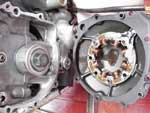
An Alternator on a Superbike ???
"Everyone" knows
you don't do this ...
|
Consider This:
By running a very small charging system, one can use a
much lighter battery. The result is better acceleration and handling !
Plus, this rider won't DNF* a race from a battery going dead
with 3 laps to go ... (these kind of "mysterious electrical
problems" actually happen more often than race tuners like to admit.)
(* DNF = Did Not Finish ... sponsors
don't like it )
.
The balance between weight, power loss, and
reliable race finishes has been
well
thought out here.
The result is:
" Championship Horsepower "
It's a lot easier to win a
championship, if you finish all the races !!
.
|
|
The starter has been removed, and so has the starter
clutch. In it's place, this Mysterious Part
has been added ....
... behind the Mystery Part is
the normal
ignition timing rotor.
|
.
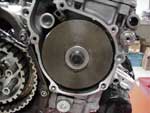
The Mystery Part
What is it ???
. |
Dry Clutch
|
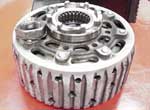
Close up of the basket reveals more lightening efforts.
The aluminum hub is drilled, and the steel backing plate has plenty of
"open spaces"
as well !!
|
Here are 2 dry clutch plates. Think of clutch plates like a brake pad and a
disc ...
.
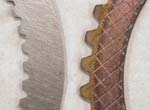
.
When a streetbike wet clutch is slipped hard during a race start, a lot of
friction plate debris gets into the engine oil.
This engine stays clean !!
|
.
With such a small power advantage, why is a dry clutch still used ??
Well,
for 1 reason winning races mean big sales increases for the factories, so money (almost) doesn't
matter when it comes to power gains.
.
The second reason is that the oil stays cleaner from the clutch particles
that are shed during hard slippage at the start of the race. This engine's
oil doesn't get contaminated no matter how hard the clutch is slipped. That can be a
big savings in the long run if even 1 engine failure & DNF can be
avoided.
.There's that "Championship"
concept again
|
... we interrupt our regularly scheduled program to bring
you this
important announcement:
Welcome Snowmobilers
!!!
In the last few months, people have been posting the Power News
articles on the snowmobile discussion forums. The response
has been tremendous, and I'd like to take the opportunity to offer those
who
signed up for Power News, a special invitation...
|
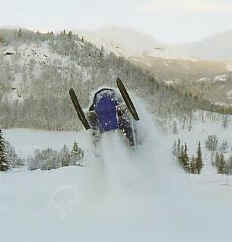
Yessss:
You Can Own The Snow !!
|
The new Yamaha RX1 snowmobile uses the
same engine design as the Yamaha R1 motorcycle engine featured in some of the Power News high velocity porting
articles.
Why not venture beyond the "box" and high velocity port the RX1
snowmobile ??? You'll have the fastest sled in the woods,
and if you race, get ready to win everything !!
I'm looking forward to doing an article on the riders who win
in the snowmobile racing scene, so anyone who is thinking about
using the Power News high velocity porting techniques on the new RX1, please let me know !!
~ MotoMan |
... and now back to our regularly scheduled
program:
Crankshaft Inertia
|
.
What's This ...
.
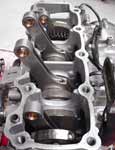
.
Why hasn't the crankshaft been lightened ?!?!?
"Everyone" knows that you should
lighten
the crankshaft when you build a real superbike !!
A lighter crankshaft allows the engine to rev
faster, and besides ...
it says so in all the racing & performance magazines !!
And now, to put some real authority on the subject:
Here's a quote from the former Vance & Hines
Yamaha & Ducati factory crew chief.
He was commenting on the new AMA Superbike rules in which 1000 4 cylinders
are allowed,
but they require the use of the unmodified stock crankshaft:
"A {4 cyl.} 1000cc Superbike won't steer as well
as a 750 {4 cyl.} or a 1000 Twin Superbike,
unless the factories make some limited
production models with much lighter crankshafts."
The reason given was that
heavier crankshafts have more gyroscopic force to overcome during
direction changes ...
which seems to make sense.
.
Uh-Ooooh ...
.
Will MotoMan stick his neck out and risk
mass ridicule by going against
all those Cool Racing Magazines ...
.
... and even a famous Factory Team Boss ???
Yup !!!
1) A lightened crankshaft gives less tractability on corner exits.
2) Usable power
is much more important than less weight or
having a cool revving sound in the pits.
3) Steering speed can be adjusted in several
other ways.
4)The
crank weight on modern engines is just right for roadracing.
(In fact, on some engines, they're almost too light...)
The Evidence:
California Speedway
(also known as
"Fontana")
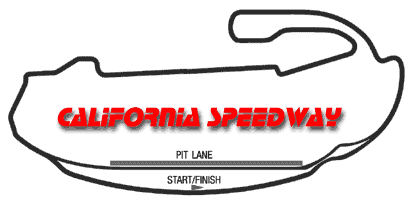
.
The California Speedway packs an amazing 21
super tight twisty "chicane" style
Left-Right-Left turns
into a relatively short 2.36-mile circuit. This must be the most chicane
infested track in the world !!
According to the "experts", the California Speedway ought to
really bring out
the worst in these heavy cranked slow turning beasts ... right ??
It looks like the poor riders of these behemoth lard cranked slugs are
just going to have to
line up behind all the super-duper-light-cranked-magic-rocket-bikes at
Fontana ...
Oooops !!
.
It turns out that those
behemoth lard cranked Suzuki GSX-R1000s
were consistently
the fastest after 2 days of recent testing at the California
Speedway !!!
|
1. Mat Mladin .......... Suzuki GSX-R1000
..........
1:25.70
2. Anthony Gobert ... Ducati 998RS ..................... 1:26.67
3. Aaron Yates ........ Suzuki GSX-R1000
..........
1:26.70
4. Ben Spies ........... Suzuki GSX-R1000
...........
1:26.82
5. Larry Pegram ...... Ducati 998RS ...................... 1:27.20
6. Eric Bostrom ....... Kawasaki ZX-7RR ................ 1:27.21 |
|
Incredibly, Mat Mladin was even quoted as
saying: "The bike steers better than the old 750."
How can this be ???
It's easy !!!! By adjusting the steering angle and the ride height, one
can make a bike steer much
faster, even if there's a lot of gyroscopic force from the crankshaft to
overcome.
This is the solution to the "heavy crank blues".
The other interesting comment from this test
session:
V-Twin Ducati rider Anthony Gobert remarked at how strong Mat Mladin's
GSXR1000 was exiting corners. Here's why: with that heavy stock Suzuki
crank, the flywheel effect gives a tremendous advantage in
controllability. The bike is going forward instead of sideways, and that's
how Mladin
could get such strong acceleration out of the corners.
Heavy crank mass makes throttle control easier, even for the multi-time
AMA superbike champ.
Are you sure you have better
throttle control than Mat Mladin ??? ... No ?? ... better leave your
crankshaft stock !!
Now for the answer to the "Mystery
Part" ...
.
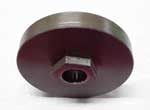
Mystery Part
.
The "Mystery Part" in
the Factory Suzuki Superbike is in fact a very heavy flywheel weight !!!
That's right, adding weight to the crank can often produce better results !!
Suzuki's not the only company to do this, Kawasaki even
offered
5% heavier than stock cranks for their ZX7R Superbike
kits.
A heavier crank increases acceleration ??? At first glance it seems
counterintuitive.
Until you think about the big picture !!!
In roadracing, most acceleration starts from a point of full lean angle,
and near zero extra traction. Accelerating from a serious lean angle is
about giving all the power the tire can take, and no more. Any sudden
lurches in the power delivery from a super-light crankshaft will just
break traction and excessively spin the tire out sideways. This kind of
riding usually chews up the
rear tire before a race is halfway over.
Once the rear tire is gone, forget about winning.
The Discovery of
Perpetual Motion ??
What energy helps to perpetuate the endless cycle of the crankshaft
lightening machine ??
.
It's That Incredibly Powerful Force Which I Call:
"M.M.M."
Mass
Marketing
... Mostly
;)
.
|
Magnesium Madness
That famous "greenish-bronze" color is evidence of magnesium.
This stuff is much lighter than aluminum !!
|
.
This oil pan holds the engine oil supply lower to keep it
away from the crank. As we've seen in the "Dry Clutch" section,
excess oil on the moving parts can rob an engine of a
lot of horsepower, and oil on the crank is especially bad.
The drawback to keeping the oil low, is that it moves more weight away
from the center of mass. This reduces the "roll rate" of the bike as it
transitions back and forth through "S" turns.
To compensate, Suzuki uses ultra lightweight (and expensive !!!!!)
magnesium on both the oil pan and oil pick-up pipe.
.
|
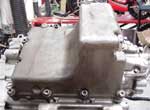
Oil Pan
It's as light as plastic !!
. |
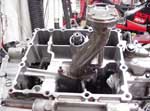
Unbelievable !!
The oil pick-up is magnesium too !!! |
To me, the shift drum was the most impressive
part in this motor !!
Wild
Transmission
|
Like most superbikes, this one uses a close ratio transmission. This means
that as the rider shifts up into a higher gear, the engine speed doesn't drop down as far into
the RPM scale.
Since the engine is at a higher average RPM, it's also higher up in average horsepower. This also allows the engine to be tuned
for more top-end power, at the expense of some low-end power.
Most streetbike transmissions use needle bearings on the outer gears, and
use bronze bushings in the inner ones. This trans used needle bearings on all the gears, and I immediately
noticed how freely the gears spun as I lifted the gearsets
from the cases.
.
|
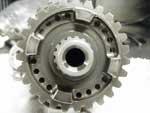
Drilled To The Max !!
The holes drilled on the outer rim make the whole gearset lighter, but
especially where it counts for quicker acceleration.
A lot of extra work goes into these parts !!
. |
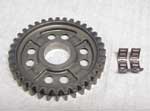
Weird Wild Bearings !!
Surprisingly, these needle bearings were of a 2 piece
"split" type
that I'd never seen before...
.
(At first, I thought I screwed something up and
broke them !!) |
Now, you're probably wondering:
Why are the gears drilled to lose
a small amount of rotating weight,
when a weight has been added to the crank to gain
a large
amount of rotating weight ???
.
The answer to this one is all
about thinking outside of the box ...
Most of the time, the combined weight of the
rotating parts in an engine is really like one mass.
But ...
Can you think of the one critical time on the racetrack when the mass of the crank
is
completely separated from the transmission ???
It's very easy to forget about this
critical time in the mad dash for more horsepower !!
|
Woe be it to the tuner who can only measure
racetrack success on a dyno ...
(This one has nothing to do with
horsepower)
Since the rules limit the transmission ratios to six, the first gear in a
superbike close ratio transmission is extremely tall. (Imagine doing a
hard start with your bike or car in second gear.)
Now imagine an extremely light crank mass combined with
145+ peaky, high RPM oriented horsepower. (Remember, this engine has
sacrificed low end power for more up on top.)
Frankly, this could be a problem.
The start of the big race will be a "wheelie-bog-wheelie-bog"
type of situation !!! (Plus it's much easier to stall, which is one of the
most dangerous situations in racing !!)
The rider struggles to control the power as he slips
the clutch. As the power hits, the bike wheelies, if the rider tries to
compensate by pulling in the clutch or turning down the throttle, the engine mass is so light that
it easily falls down into it's lower RPM range where there's no usable
power. Any way you look at it, being off the power isn't good when
everyone else has full throttle !!
Suddenly, the bike that looked so good on the dyno is getting totally
smoked by the other riders during the start !!
Now our rider has to work extra hard to pass many riders to take the
lead. This additional effort wears down the rider as well as the tires.
After spending tons of money to reach this point,
the big win is almost impossible.
What Suzuki does is to start with all light rotating components, and then
the "Mystery Part" flywheel is added to compensate. Different weights are
available, according to the preference
of the rider.
This strikes the best compromise between good starts and tractable
acceleration out of turns against the least amount of
excess weight on the bike as possible.
..
|

The Mystery Part
also helps the rider to get:
..
Way Better Starts !!
You see ... that crazy
"Mystery Part" is
really all about the big picture ...
Faster lap times through tractability, and better starts will make a huge
difference at the end of the season when all those final
championship
points are added up !!
It's all about.
" Championship Horsepower "
|
Where do innovations and inventions come from ???
Thomas Edison once said that ideas just came to him from "space"...
S
That may have worked for Edison, but for most of us, discovering a new idea is a
more
"Pro-Active" process, wouldn't you agree ???
Power News Exclusive:
The Explanation For What Thomas Edison
Couldn't Explain
The "space" that Edison was talking about was simply that he balanced logic
& creativity !!
It's important to note that this worked especially well because
Edison
wasn't afraid to "think wrong".
.
(He was a lot like Mr. Spock in this way...)
This unique combination of attributes allowed him to apply many seemingly
unimportant or "wrong" concepts into a
workable relation that had
never occurred to anyone else !!!
 |
50-50
When both
sides of our brain work towards a 50-50 balance, we get super intelligence.
but ....
When one side tries to dominate or fight the other side, we never see the "big pictures".
(This "fight" is the most common block to
Thinking Outside Of The Box...)
|
Thomas Edison had skills that we are all born with !!!
The only difference was:
He just never lost them as he "grew up".
(How can we lose an intelligence we are born
with ???)
The answer is: it gets
learned
out of us before we even reach adulthood !!!
Learning isn't the problem, just the process by which it
usually happens:
As young kids, we learn things mostly because adults say
"No", "Don't
do that", "Never", "Stop
that", or even "Shut up" ....
... and then we get rewarded when we finally do the
" right " thing.
Next, as we get a little older, we learn by the true
or false system which
teaches us that there's a right way to think and a wrong
way to think.
Eventually, we become afraid of
thinking "wrong".
This has the effect of training the mind to only see 2
options for every problem !!
We have a conditioned tendency to
think :
" it's either up
or down " ...
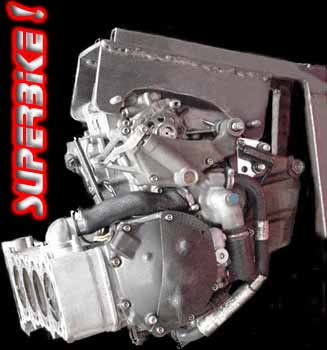
|
... when maybe
sideways ...
or around the back ...
or inside-out ...
or over there ...
or through the
middle ...
or underneath ...
or hardly anywhere ...
|
are much better solutions !!
The result of the right and wrong
thinking system,
is that by the time we reach adulthood, we gradually
memorize a lot of facts
and lose the immaturity of childhood.
ironically ...
in this process of repeating the same patterns of fixed thinking,
we gradually lose the powerful ability
to " Think Outside Of The Box
"
... even though we're all born with this natural talent
!!
|
Those who've
completely
lost that ability
... are
completely
unaware that
they've ever had it !!
|
.
.
.
.
.
. |
" When I examined myself and my
methods of thought, I came to the conclusion that the gift of fantasy has meant
more to me than my talent for absorbing positive knowledge."
.
~ Albert Einstein
" The secret to developing a powerful intellect is to
practice thinking with the same
wild imagination as
you did when you were a kid. "
.
~ MotoMan
What About The Factory Suzuki Superbike Intake Ports ???
.
Well, as you might have guessed by now ... they're just cleaned up stock
ports,
not enlarged for more "flow", but definitely not high velocity !!!
That's right:
The '97 Factory Suzuki Superbike Team didn't read
Power News ... it wasn't even "invented" back then !!
(The entire audience gasps in
shocked amazement)
|
.
Hard Break In ?? ...Turned In Exhaust Pipes ?? ...Smaller Ports ??
... Heavy Crankshafts ??
"A lot of it goes against accepted engine
theory ... but it all works"
|

![]()

![]() issue better than the last.
issue better than the last.![]()

![]()
![]()
![]()
![]()
![]()
![]()
![]()
![]()
![]() Stay tuned to Power News to learn all
the tricks
Stay tuned to Power News to learn all
the tricks ![]() }
}

